Strength Properties of Sustainable Mortar Containing Waste Steel Slag and Waste Clay Brick: Effect of Temperature
Abstract
1. Introduction
2. Experimental Methodology
2.1. Materials and Mix Design
2.2. Experimental Program and Test Procedures
3. Results and Discussion
3.1. Tensile and Flexural Strength at Normal Temperature
3.2. Dry Density and Mass Loss after Exposure to Elevated Temperatures
3.3. Tensile and Flexural Strength after Exposure to Elevated Temperatures
4. Conclusions
- At normal temperature, both tensile and flexural strength increased with the increasing percentage of WSS (50–76% for tensile and 39–68% for flexural strength), while the strength increased for 50% WCB (16–25% for tensile and 18–37% for flexural strength) and decreased for 100% WCB compared to 100% NS.
- The long-term strength of mortar made with WSS and WCB was better than that made with NS due to the micro-filler and possible activation of the pozzolanic reaction due to the sufficient specific surface area WSS and WCB permitting the pozzolanic reaction.
- The dry density of the mortar mixes decreased with an increase in thermal load, and the drop was higher at the higher temperature (e.g., at 600 °C) and at 100% WCB. These results agree with the higher mass loss at the highest temperature and higher content of WCB.
- The tensile and flexural strength of all mortar mixes decreased with increasing exposure temperature, with a significant effect at higher temperatures. The residual strength of mortar made with 100% NS, 100% WSS and 50% WCB after exposure to 600 °C was 48, 40 and 34%, respectively, for tensile strength, and 40, 30 and 30%, for flexural strength, compared to the strength of unheated specimens.
- Natural sand can be entirely replaced by WSS and by 50% WCB.
Author Contributions
Funding
Institutional Review Board Statement
Informed Consent Statement
Data Availability Statement
Acknowledgments
Conflicts of Interest
References
- Rakhimova, N.R.; Rakhimov, R.Z. Alkali-activated cements and mortars based on blast furnace slag and red clay brick waste. Mater. Des. 2015, 85, 324–331. [Google Scholar] [CrossRef]
- Dang, J.; Zhao, J.; Hu, W.; Du, Z.; Gao, D. Properties of mortar with waste clay bricks as fine aggregate. Constr. Build. Mater. 2018, 166, 898–907. [Google Scholar] [CrossRef]
- Liu, Q.; Singh, A.; Xiao, J.; Li, B.; Tam, V.W. Workability and mechanical properties of mortar containing recycled sand from aerated concrete blocks and sintered clay bricks. Resour. Conserv. Recycl. 2020, 157, 104728. [Google Scholar] [CrossRef]
- Schackow, A.; Stringari, D.; Senff, L.; Correia, S.L.; Segadães, A.M. Influence of fired clay brick waste additions on the durability of mortars. Cem. Concr. Compos. 2015, 62, 82–89. [Google Scholar] [CrossRef]
- Shi, C. Characteristics and cementitious properties of ladle slag fines from steel production. Cem. Concr. Res. 2002, 32, 459–462. [Google Scholar] [CrossRef]
- Bektas, F.; Wang, K.; Ceylan, H. Effects of crushed clay brick aggregate on mortar durability. Constr. Build. Mater. 2009, 23, 1909–1914. [Google Scholar] [CrossRef]
- Mazumder, A.R.; Kabir, A.; Yazdani, N. Performance of overburnt distorted bricks as aggregates in pavement works. J. Mater. Civ. Eng. 2006, 18, 777–785. [Google Scholar] [CrossRef]
- Liu, G.; Schollbach, K.; van der Laan, S.; Tang, P.; Florea, M.V.; Brouwers, H.J.H. Recycling and utilization of high volume converter steel slag into CO2 activated mortars—The role of slag particle size. Resour. Conserv. Recycl. 2020, 160, 104883. [Google Scholar] [CrossRef]
- Santamaría-Vicario, I.; Rodríguez, A.; Gutiérrez-González, S.; Calderón, V. Design of masonry mortars fabricated concurrently with different steel slag aggregates. Constr. Build. Mater. 2015, 95, 197–206. [Google Scholar] [CrossRef]
- Guo, Y.; Xie, J.; Zhao, J.; Zuo, K. Utilization of unprocessed steel slag as fine aggregate in normal- and high-strength concrete. Constr. Build. Mater. 2019, 204, 41–49. [Google Scholar] [CrossRef]
- Mo, L.; Zhang, F.; Deng, M.; Jin, F.; Al-Tabbaa, A.; Wang, A. Accelerated carbonation and performance of concrete made with steel slag as binding materials and aggregates. Cem. Concr. Compos. 2017, 83, 138–145. [Google Scholar] [CrossRef]
- Pan, Z.; Zhou, J.; Jiang, X.; Xu, Y.; Jin, R.; Ma, J.; Chen, W. Investigating the effects of steel slag powder on the properties of self-compacting concrete with recycled aggregates. Constr. Build. Mater. 2019, 200, 570–577. [Google Scholar] [CrossRef]
- Kolawole, J.T.; Olusola, K.O.; Babafemi, A.J.; Olalusi, O.B.; Fanijo, E. Blended cement binders containing bamboo leaf ash and ground clay brick waste towards the use for sustainable concrete. Materialia 2021, 15, 101045. [Google Scholar] [CrossRef]
- Afshinnia, K.; Poursaee, A. The potential of ground clay brick to mitigate Alkali–Silica Reaction in mortar prepared with highly reactive aggregate. Constr. Build. Mater. 2015, 95, 164–170. [Google Scholar] [CrossRef]
- Dang, J.; Zhao, J. Influence of waste clay bricks as fine aggregate on the mechanical and microstructural properties of concrete. Constr. Build. Mater. 2019, 228, 116757. [Google Scholar] [CrossRef]
- He, Z.; Shen, A.; Wu, H.; Wang, W.; Wang, L.; Yao, C.; Wu, J. Research progress on recycled clay brick waste as an alternative to cement for sustainable construction materials. Constr. Build. Mater. 2021, 274, 122113. [Google Scholar] [CrossRef]
- Pan, Z.; Tao, Z.; Murphy, T.; Wuhrer, R. High temperature performance of mortars containing fine glass powders. J. Clean. Prod. 2017, 162, 16–26. [Google Scholar] [CrossRef]
- Salahuddin, H.; Nawaz, A.; Maqsoom, A.; Mehmood, T. Effects of elevated temperature on performance of recycled coarse aggregate concrete. Constr. Build. Mater. 2019, 202, 415–425. [Google Scholar] [CrossRef]
- Natarajan, S.; Udayabanu, M.; Ponnan, S.; Murugan, S. Performance of Nano-Silica Modified Self-Compacting Glass Mortar at Normal and Elevated Temperatures. Materials 2019, 12, 437. [Google Scholar] [CrossRef] [PubMed]
- Tran, T.T.; Kang, H.; Kwon, H.-M. Effect of Heat Curing Method on the Mechanical Strength of Alkali-Activated Slag Mortar after High-Temperature Exposure. Materials 2019, 12, 1789. [Google Scholar] [CrossRef]
- Tran, T.T.; Kwon, H.-M. Influence of Activator Na2O Concentration on Residual Strengths of Alkali-Activated Slag Mortar upon Exposure to Elevated Temperatures. Materials 2018, 11, 1296. [Google Scholar] [CrossRef]
- Roy, S.; Miura, T.; Nakamura, H.; Yamamoto, Y. High temperature influence on concrete produced by spherical shaped EAF slag fine aggregate—Physical and mechanical properties. Constr. Build. Mater. 2020, 231, 117153. [Google Scholar] [CrossRef]
- Nedeljković, M.; Visser, J.; Nijland, T.G.; Valcke, S.; Schlangen, E. Physical, chemical and mineralogical characterization of Dutch fine recycled concrete aggregates: A comparative study. Constr. Build. Mater. 2021, 270, 121475. [Google Scholar] [CrossRef]
- ASTM. C136/C136M-14. Standard Test Method for Sieve Analysis of Fine and Coarse Aggregates; ASTM International: West Conshohocken, PA, USA, 2014. [Google Scholar]
- ASTM. C128-15. Standard Test Method for Relative Density (Specific Gravity) and Absorption of Fine Aggregate; ASTM International: West Conshohocken, PA, USA, 2015. [Google Scholar]
- ASTM. C29/C29M-17a. Standard Test Method for Bulk Density (“Unit Weight”) and Voids in Aggregate; ASTM International: West Conshohocken, PA, USA, 2017. [Google Scholar]
- ASTM. C307-18. Standard Test Method for Tensile Strength of Chemical-Resistant Mortar, Grouts, and Monolithic Surfacings; ASTM International: West Conshohocken, PA, USA, 2018. [Google Scholar]
- ASTM. C348-19. Standard Test Method for Flexural Strength of Hydraulic-Cement Mortars; ASTM International: West Conshohocken, PA, USA, 2019. [Google Scholar]
- Hager, I.G. Comportement à Haute Température des Bétons à Haute Performance-Évolution des Principales Propriétés Mécaniques. Ph.D. Thesis, l’Ecole Nationale des Ponts et Chaussées et l’Ecole Polytechnique de Cracovie, Paris, France, 2004. [Google Scholar]
- Miah, M.J. The Effect of Compressive Loading and Cement Type on the Fire Spalling Behaviour of Concrete. Ph.D. Thesis, Université de Pau et des Pays de l’Adour, Pau, France, 19 October 2017. [Google Scholar]
- Monte, F.L.; Felicetti, R.; Miah, M.J. The influence of pore pressure on fracture behaviour of Normal-Strength and High-Performance Concretes at high temperature. Cem. Concr. Compos. 2019, 104, 103388. [Google Scholar] [CrossRef]
- Miah, M.J.; Ali, M.K.; Paul, S.C.; Babafemi, A.J.; Kong, S.Y.; Šavija, B. Effect of recycled iron powder as fine aggregate on the mechanical, durability, and high temperature behavior of mortars. Materials 2020, 13, 1168. [Google Scholar] [CrossRef]
- Kalifa, P.; Chene, G.; Galle, C. High-temperature behaviour of HPC with polypropylene fibres: From spalling to microstructure. Cem. Concr. Res. 2001, 31, 1487–1499. [Google Scholar] [CrossRef]
- Bazant, Z.P. Analysis of pore pressure, thermal stress and fracture in rapidly heated concrete. In Proceedings of the International Workshop on Fire Performance of High-Strength Concrete, Gaithersburg, MD, USA, 13–14 February 1997; NIST: Gaithersburg, MD, USA, 1997; pp. 155–164. [Google Scholar]
- Miah, M.J.; Lo Monte, F.; Felicetti, R.; Carré, H.; Pimienta, P.; La Borderie, C. Fire spalling behaviour of concrete: Role of mechanical loading (uniaxial and biaxial) and cement type. Key Eng. Mater. 2016, 711, 549–555. [Google Scholar] [CrossRef]
- Li, Y.; Tan, K.H.; Yang, E.-H. Influence of aggregate size and inclusion of polypropylene and steel fibers on the hot permeability of ultra-high performance concrete (UHPC) at elevated temperature. Constr. Build. Mater. 2018, 169, 629–637. [Google Scholar] [CrossRef]
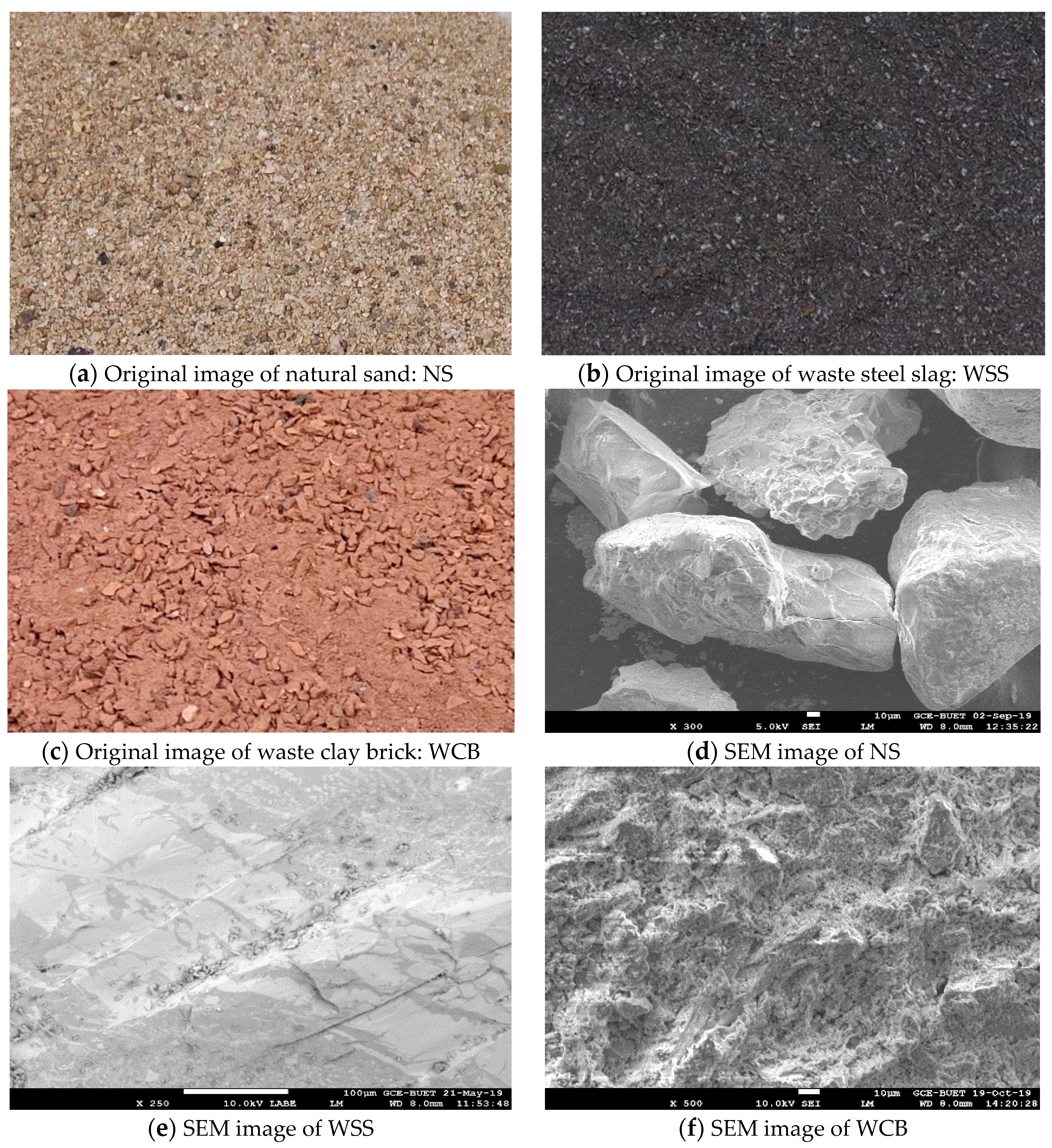

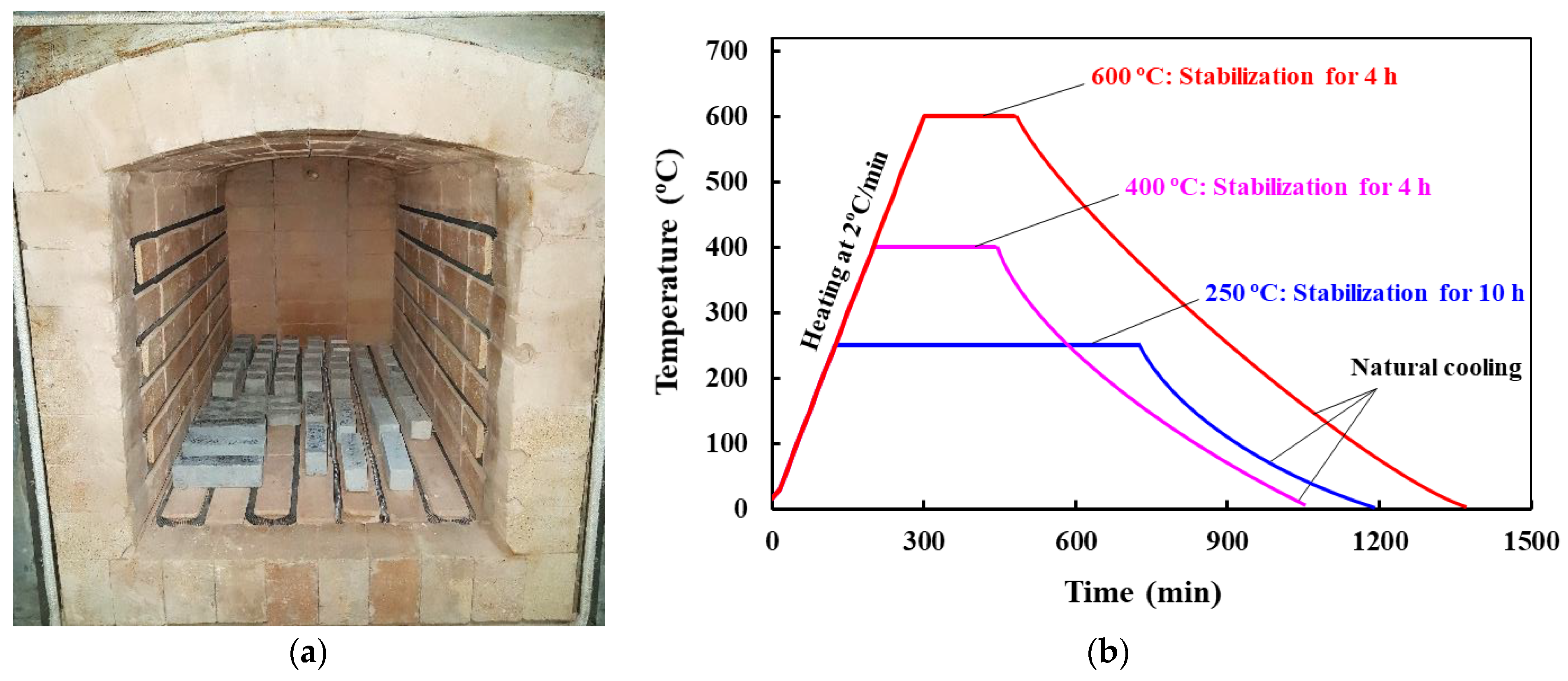
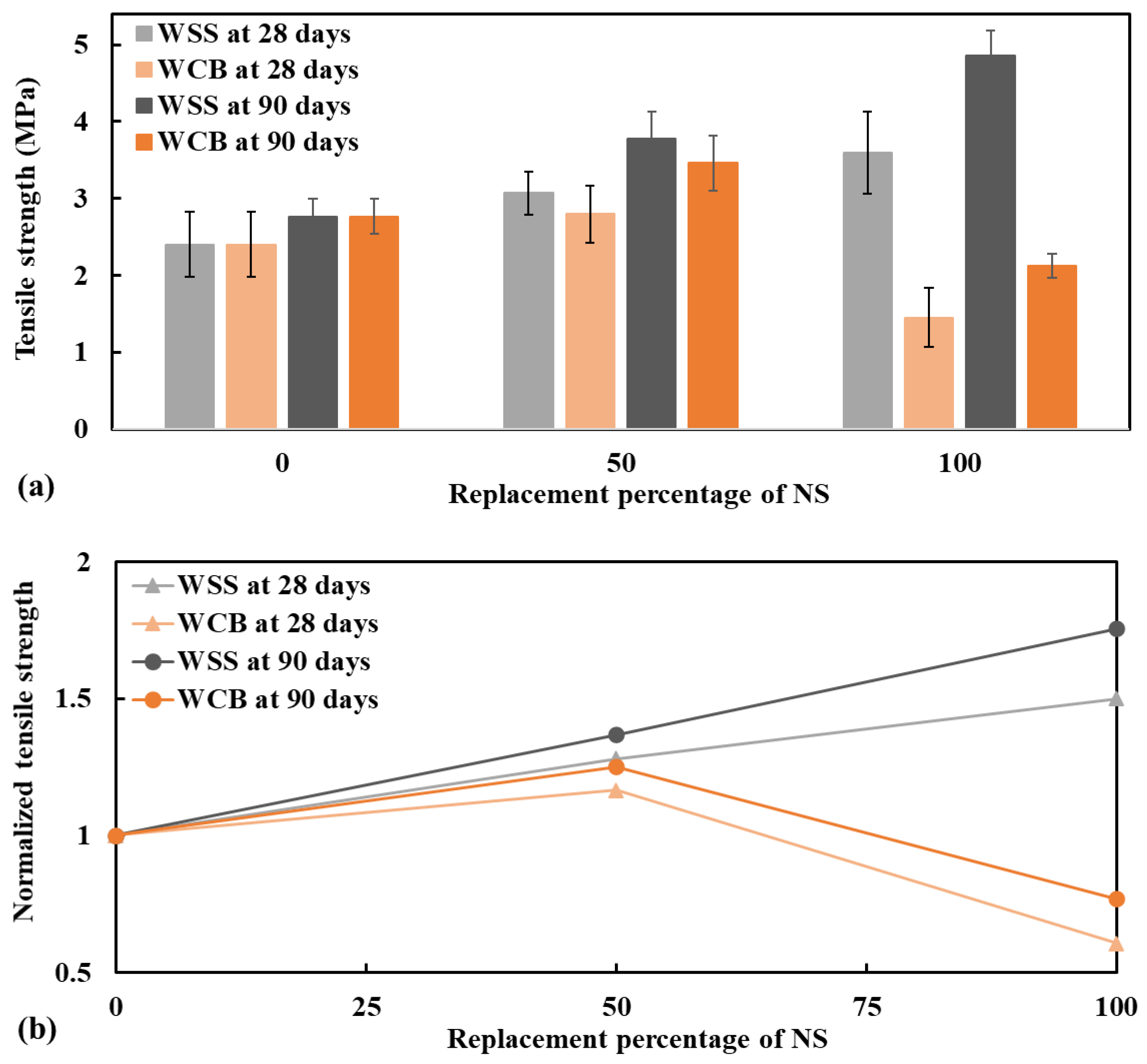


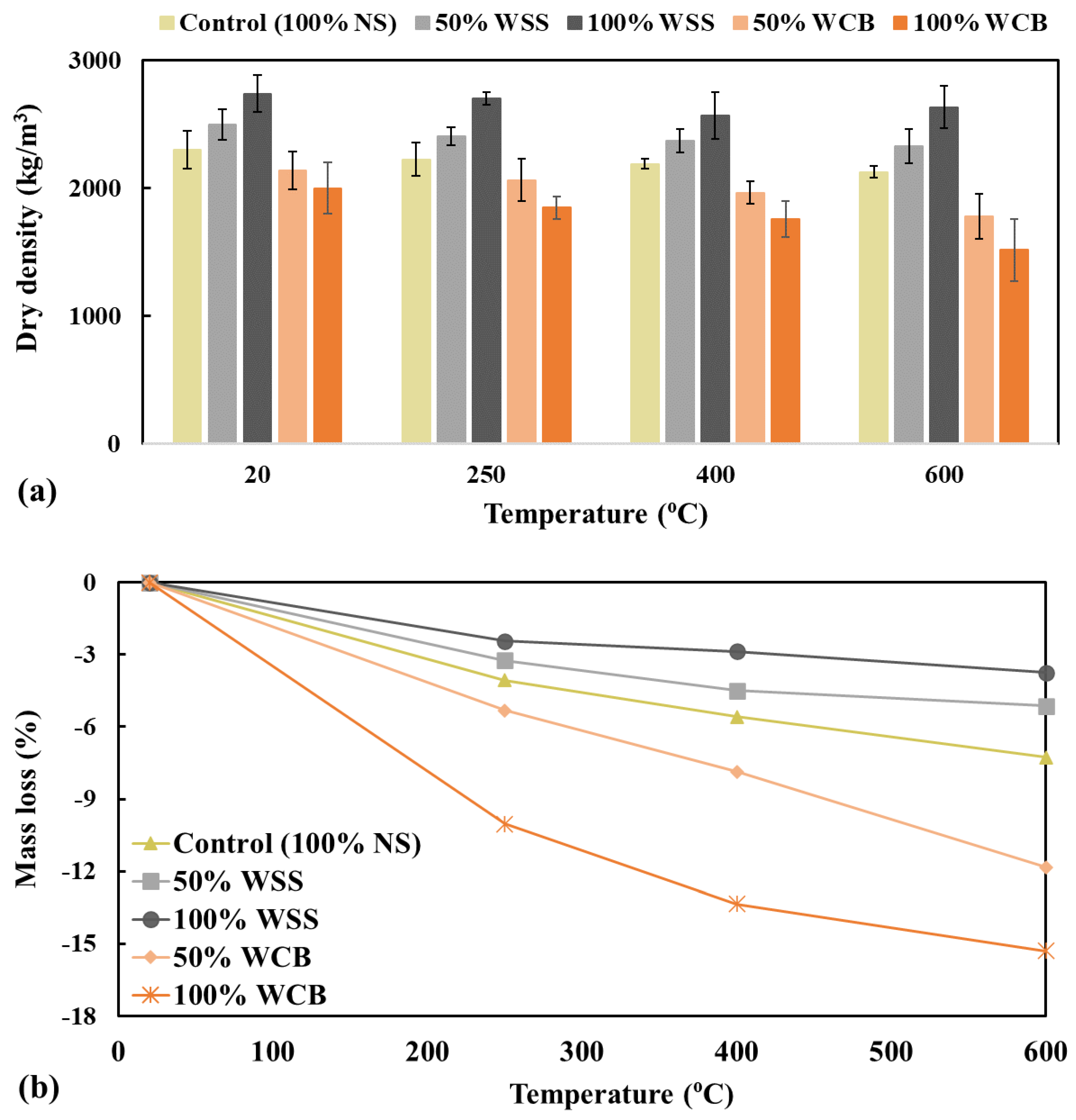

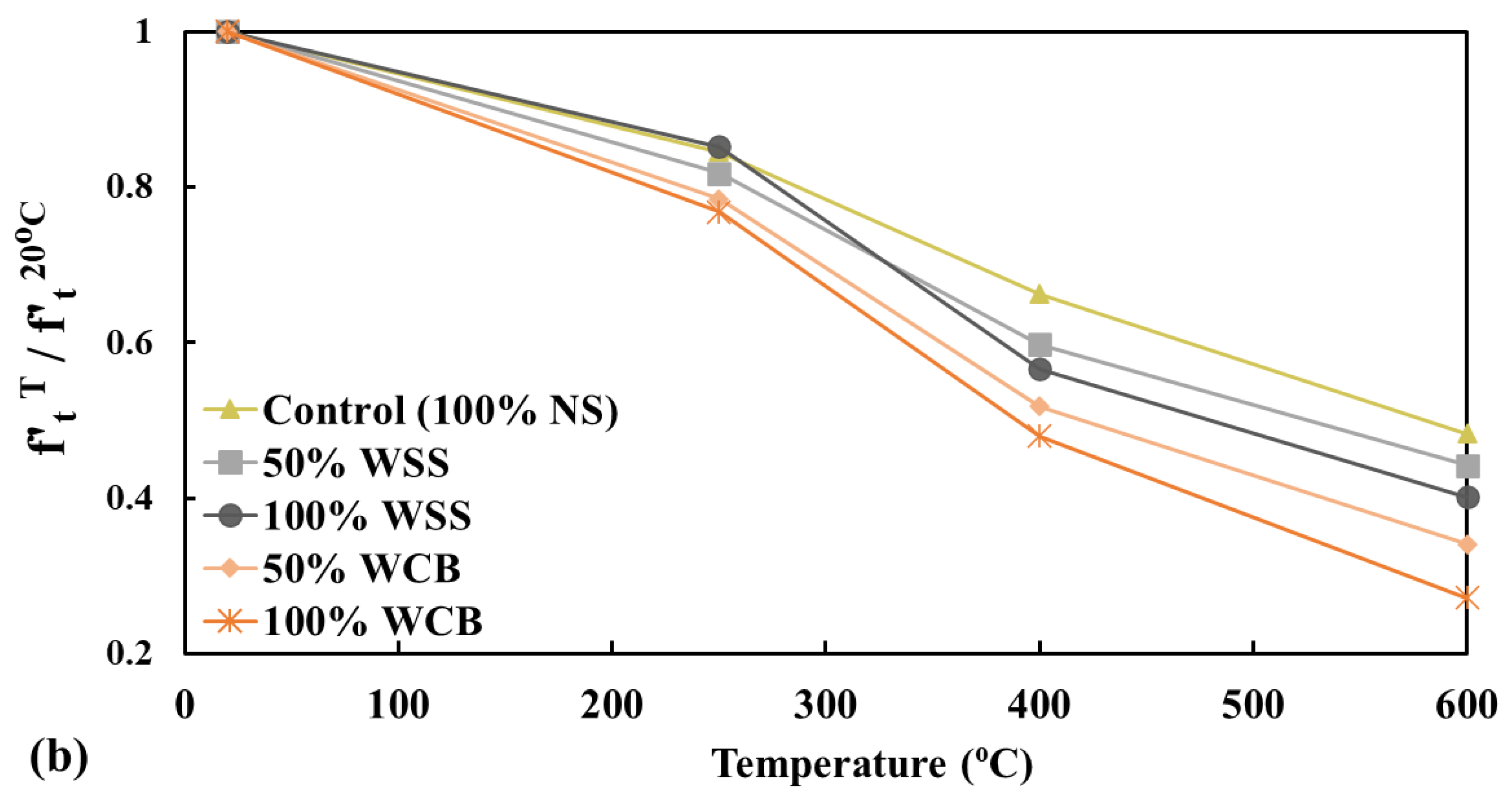
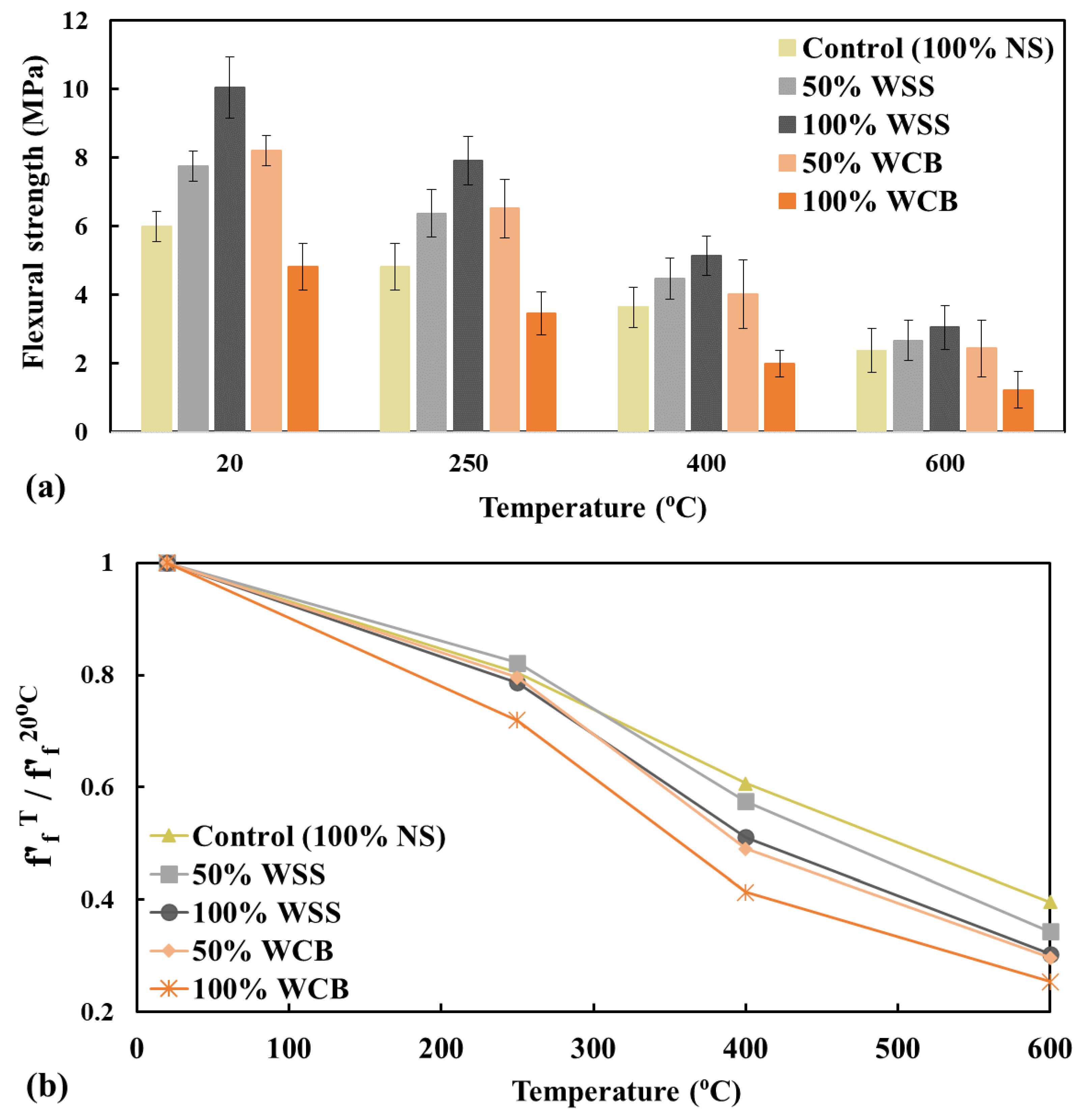
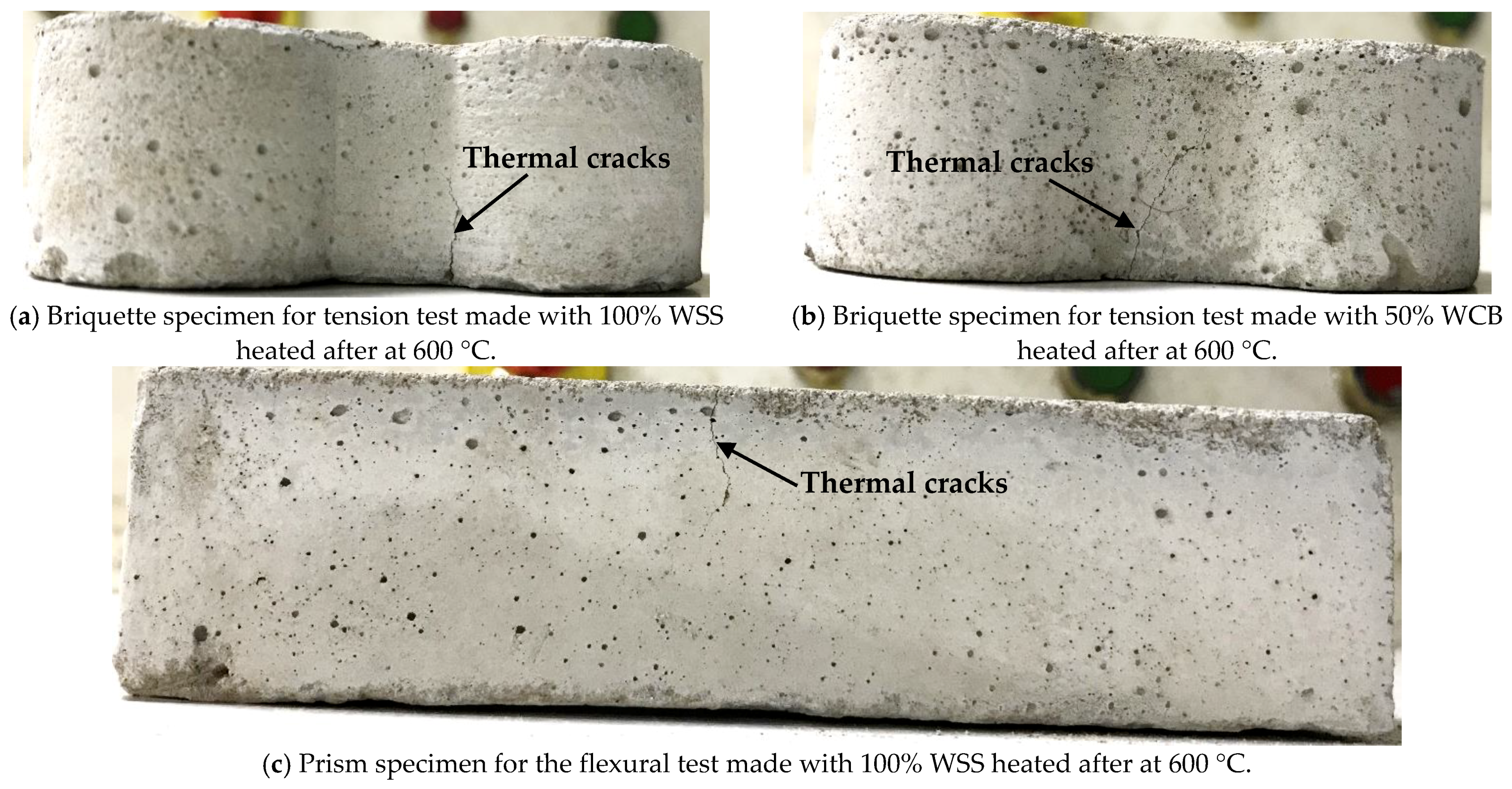

| Chemical Composition | Cement (%) | NS (%) | WSS (%) | WCB (%) |
|---|---|---|---|---|
| SiO2 | 24.90 | 75.45 | 26.18 | 60.43 |
| Fe2O3 | 3.96 | 5.08 | 44.39 | 14.27 |
| Al2O3 | 7.52 | 7.62 | 4.94 | 9.96 |
| K2O | 1.00 | 4.62 | 0.56 | 5.23 |
| CaO | 53.43 | 3.13 | 4.94 | 4.18 |
| TiO2 | 1.18 | 0.69 | 1.73 | 1.81 |
| MgO | 2.52 | 1.26 | 0.47 | 1.69 |
| Na2O | 0.27 | 1.72 | 0.45 | 0.90 |
| SO3 | 4.77 | - | 0.43 | 0.57 |
| MnO | 0.07 | 0.08 | 12.90 | 0.30 |
| P2O5 | 0.21 | 0.17 | 0.08 | 0.24 |
| ZrO2 | 0.01 | - | 0.11 | 0.05 |
| SrO | 0.08 | 0.04 | 0.09 | 0.05 |
| Mix ID | Cement | Fine Aggregates | Water | ||
|---|---|---|---|---|---|
| NS | WSS | WCB | |||
| Control | 544.7 | 1361.8 | - | - | 272.4 |
| 50% WSS | 544.7 | 680.9 | 861.7 | - | 272.4 |
| 100% WSS | 544.7 | - | 1723.5 | - | 272.4 |
| 50% WCB | 544.7 | 680.9 | - | 452.1 | 272.4 |
| 100% WCB | 544.7 | - | - | 904.3 | 272.4 |
Publisher’s Note: MDPI stays neutral with regard to jurisdictional claims in published maps and institutional affiliations. |
© 2021 by the authors. Licensee MDPI, Basel, Switzerland. This article is an open access article distributed under the terms and conditions of the Creative Commons Attribution (CC BY) license (https://creativecommons.org/licenses/by/4.0/).
Share and Cite
Miah, M.J.; Paul, S.C.; Babafemi, A.J.; Panda, B. Strength Properties of Sustainable Mortar Containing Waste Steel Slag and Waste Clay Brick: Effect of Temperature. Materials 2021, 14, 2113. https://doi.org/10.3390/ma14092113
Miah MJ, Paul SC, Babafemi AJ, Panda B. Strength Properties of Sustainable Mortar Containing Waste Steel Slag and Waste Clay Brick: Effect of Temperature. Materials. 2021; 14(9):2113. https://doi.org/10.3390/ma14092113
Chicago/Turabian StyleMiah, Md Jihad, Suvash Chandra Paul, Adewumi John Babafemi, and Biranchi Panda. 2021. "Strength Properties of Sustainable Mortar Containing Waste Steel Slag and Waste Clay Brick: Effect of Temperature" Materials 14, no. 9: 2113. https://doi.org/10.3390/ma14092113
APA StyleMiah, M. J., Paul, S. C., Babafemi, A. J., & Panda, B. (2021). Strength Properties of Sustainable Mortar Containing Waste Steel Slag and Waste Clay Brick: Effect of Temperature. Materials, 14(9), 2113. https://doi.org/10.3390/ma14092113









